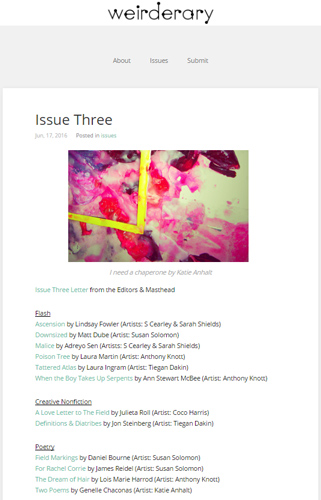weirderary – June 2016
weirderary is that kid in high school who, when called weird, would smile proudly and say, “Thanks.” weirderary is the weird things you do at home when you think no one’s watching. weirderary is exactly the kind of read I’ve been looking for.
weirderary is that kid in high school who, when called weird, would smile proudly and say, “Thanks.” weirderary is the weird things you do at home when you think no one’s watching. weirderary is exactly the kind of read I’ve been looking for.
This issue is split into flash, creative nonfiction, poetry, interviews, book reviews, and a mysterious section titled “other.” Each piece in the creative section of the magazine is accompanied by art, all well-chosen for its accompanying writing.
Lindsay Fowler sets the tone with the first piece of flash fiction “Ascension.” After a woman’s death, she finds that she is an elevator who always yearns for ascension, for freedom. Fowler snags readers in with the first few sentences and the strangeness of the situation: “After she died, the woman awoke to discover that she had become an elevator. Well, not awoke, exactly; her doors slid open slowly and her interior lights blinked on; it was a slow unfolding of consciousness, like a switch had been thrown somewhere far away.” It’s not often one reads the point of view of an elevator.
Jon Steinberg answers the question of what it feels like going blind in his nonfiction piece “Definitions & Diatribes”: “It feels like I’m going insane.” From here he builds a list of common sight-related items, sayings, and references: “Blind. Partially sighted. Legally Blind. Snow-blind. Blind as a bat. Blind like Stevie Wonder. [ . . . ] Crazy eyes. Bedroom eyes. Living in the public eye. The apple of my eye. The shitty Eagles singing about a woman with lying eyes. Blind drunk.” He ends answering the question of what it’s like to go blind like once more. Steinberg gives us a vacation from the usual nonfiction piece, and if his recently finished memoir is anything similar, I’m keeping my own fingers crossed it gets picked up for publication soon.
In poetry, it’s impossible to pick a favorite. Daniel Bourne’s makes birds sexy in “Field Markings,” using vivid language: “[ . . . ] raw pinks in innocent spaces: // The fierce throb of rose-breasted grosbeak,” and Lois Marie Harrod’s “The Dream of Hair” conjures up images that range from creepy: “covered with hair, / thin and stringy” to soft and sensual: “but my breasts / kept rising like dough / like scoops of cream.” James Reidel dedicates “For Rachel Corrie” to the American activist who was killed by a bulldozer in 2003. He compares her burning a makeshift American flag to his own flag-building as a child on Flag Day, a heartfelt and touching piece. Both of Genelle Chaconas’s poems sweep readers in, the lack of punctuation forcing one to read all the way through in one hurried breath. The editors did a great job in selecting this issue’s poetry.
In that mysterious “Other” section is a video by Hannah Barnhardt titled “The Red Priestess.” The video is less than a minute and shows who I assume is Barnhardt in what looks like an outfit made of yarn. Movement, breath, light, and shadow create a hypnotic effect.
weirderary takes its weirdness seriously; even the interviews aren’t exactly what readers might be expecting. Jacob M. Appel returns for a running “joke” that he be interviewed every issue, and the first question asked of Jane Liddle is, “What’s the biggest animal you’ve ever touched?” before continuing on to questions about writing and Liddle’s book, Murder.
weirderary has found the right blend of weird. Never too over-the-top and always interesting, the online magazine serves as a reminder that it’s okay to be different. There’s always a place for you at weirderary.
[www.weirderary.com]






